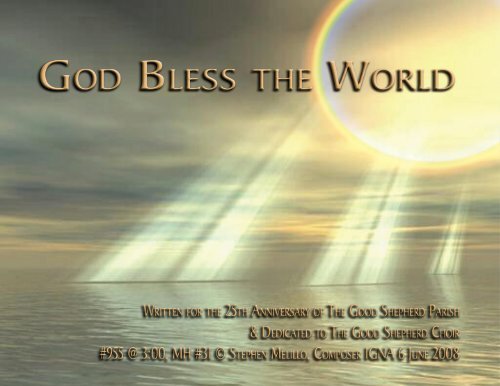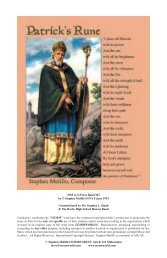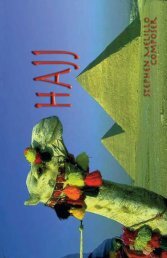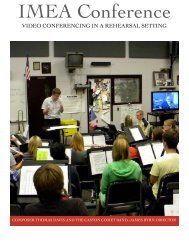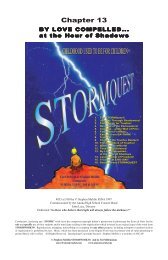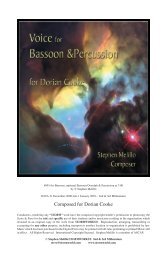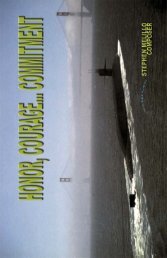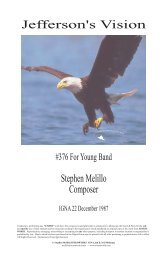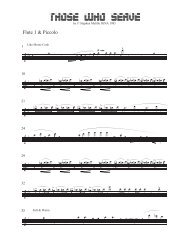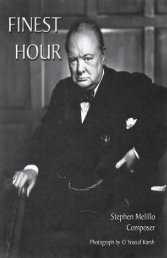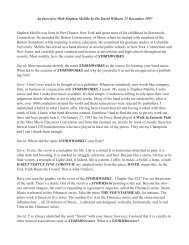GOD Bless the WORLD, Musical Haiku #31, #955 ... - STORMWORLD
GOD Bless the WORLD, Musical Haiku #31, #955 ... - STORMWORLD
GOD Bless the WORLD, Musical Haiku #31, #955 ... - STORMWORLD
- No tags were found...
You also want an ePaper? Increase the reach of your titles
YUMPU automatically turns print PDFs into web optimized ePapers that Google loves.
iTunesleftBassDrum 2leftspeakerLaptop 1:iTUNESTracksTIME to TAKEBACK <strong>the</strong>KNIGHTS! &American KnightsVocalSoloTheSpeechofAngelsLaptop 2:opt.VirtualChoirWAITof <strong>the</strong><strong>WORLD</strong>MalletsTrumpets 3-2-13-2-1 ClarinetsIN a CAUSECALLED“GLORIOUS”B.ClarIN a SERVICEBEYONDSELFTrombones 1-2-3 (bass)Horns 2314PicAmpPAD BassA BRIEF INTRO TOMUSIC BY STEPHEN MELILLODynamics are exaggerated by stressing <strong>the</strong> quieter markings.Crescendo markings which do not indicate a "starting" volumelevel should be considered as starting from "nothing". Follow<strong>the</strong> line shapes dynamically. As a general statement... What opensup in terms of interval should also open up in terms of faster airand bow. For bow markings, I defer to <strong>the</strong> conductor and concertmaster.A crescendo has a different correlation to time as it expandsto a destination or “arrival” point in STORM Music. Thepicture below, better illustrates <strong>the</strong> effect, which, to ensure agreat rendering, must be felt and not merely executed. FromSilence, stay to <strong>the</strong> lower portion of <strong>the</strong> slope longer... pushing<strong>the</strong> dynamic effect closer to <strong>the</strong> end or destination point.Percussionists should fur<strong>the</strong>r exaggerate this effect, allowing <strong>the</strong>winds to remain transparent, staying out of <strong>the</strong> crescendo until <strong>the</strong>very last moments. Non-pitched percussionists and people playingrepeated notes under lines that rise and fall must do <strong>the</strong>ir best tolisten and swell appropriately. The result should be a continuoussuccession of rising and falling, swelling and building. Thedynamic architecture is <strong>the</strong> Music.INTENDED ACCENTS are often <strong>the</strong> result of <strong>the</strong> way <strong>the</strong>rhythms are grouped. These are rendered automatically and it saves<strong>the</strong> eye <strong>the</strong> additional burden of seeing accent markings above everynote. Unless marked to <strong>the</strong> contrary, usually with tenuto markings,syncopated rhythms automatically receive alift, a separation, an accent. A tuplet figure inmusic in 2’s is syncopated, <strong>the</strong>refore, stressedand separated. A duplet figure in music in 3’s issyncopated, <strong>the</strong>refore stressed and separated. Thislift and separation are of paramount importance inestablishing impetus, pulse and relentless drama.SuiteBEYONDCOURAGE This marking: , in all of <strong>the</strong> “storm” Music,A Documentaryin MusicIN THEBEGINNING!means that <strong>the</strong> note should have a weighted,symphonic accent. Imagine a full downbowAll <strong>the</strong> Teaching Tools andswiped across <strong>the</strong> string. A swipe is <strong>the</strong> best way<strong>GOD</strong>SPEED!CONNECTIONSall that is soon to bewritten...I can explain it... full, fast and hard. It is notnecessarily short and it is much more like a jazzESCAPEfromPLATO’sstyle notation... “AAHT!”CAVES-MatrixSymphony IIJazz &AHAB!Concerto for15 ChaptersOrchestralTEDDYViolinofMusicERICHA conductor, in viewing <strong>the</strong> score, may find anWISH toDAVID<strong>the</strong> <strong>WORLD</strong>ffffffMUSASHIHIM11 OriginalA Major chord, for example, spelled verticallyShows for <strong>the</strong> ffff13 ChaptersFieldofWPIMas A, Db, E. Please understand that <strong>the</strong> Music isSTORMfJourneys“I” of <strong>the</strong> STORMfWithoutconceived in a horizontal manner and that notesAfter <strong>the</strong>WarningmfVs. mfSTORMHonor,16 ChaptersSON of <strong>the</strong>CouragempmpofSTORMCommitmentand enharmonics are chosen based on, more timesThe FirstSTORMQuest&The LastONLY forppNOWthan not, what <strong>the</strong> instrumental Musician willSTORMWORKS ppppArt of <strong>the</strong> Stateread.&By Love InviolateO Come HolyppppppNight!Giving!Festival of Light!America <strong>the</strong> Brave!TheTime TimeSTAR!FOUNTAINHEAD<strong>GOD</strong> <strong>Bless</strong>The HARP, electronic or not, <strong>the</strong> PIANO,AmericaERICH!electronic or not and <strong>the</strong> PAD BASS mustbe mixed into <strong>the</strong> ensemble as any acousticinstrument would be. Just think of <strong>the</strong>se sounds as REAL and beautiful and capable of orchestral dimension. A new world of colour and student involvementawaits those who will patiently explore <strong>the</strong> wind and percussion ensemble of <strong>the</strong> 3rd Millennium. Please see my Seating Chart for placement and visitSTORM<strong>WORLD</strong> for more.HARP notation is written for a one-staved harp... (considering, of course, that <strong>the</strong> part is most likely to be played on a keyboard.) Therefore, <strong>the</strong> Musicianshould be aware of how to respond to harp notation. A 7-note figure with a harp-like graphic notation represents a gliss across <strong>the</strong> whole keyboard. Do notexceed C5 as this will sound uncharacteristic. Glissandi only occur across <strong>the</strong> white keys, a strategy which allows for all ages to create sounds more oftenassociated with <strong>the</strong> Orchestra. Fast rhythmic figures are designed to work as tremolos between <strong>the</strong> two hands. The faster written rhythms, sextuplets or 32ndnotes are not to be read precisely, but as splashes of colour and rendered in a harp-like manner.Percussion of Choice: One 18” Medium-Thin and one 16” Paper-Thin Zildjian Suspended Cymbals, one 22” Medium-Heavy German Symphonic ZildjianCrash, one Tambourine with German Silver Jingles, one Piccolo Snare, tightly tuned with coated batter head, Deagan Silver Chimes, Large Orchestral BassDrum, and of course, <strong>the</strong> highest possible quality of Timpani. The designation “Glockenspiel” always means “Orchestra Bells”.As always, <strong>the</strong>re is a tremendous dichotomy in <strong>the</strong> Music I write, a duality that at one moment demands exact, relentless, unyielding pulse... and <strong>the</strong>n suddenlycalls upon <strong>the</strong> sensitive breath-like phrasing of an insightful Conductor. To your sensitive vision, I leave <strong>the</strong>se languid moments... those whispers which, indeed,∕¤‹›© STORMWORKS COPYRIGHT NOTICE FOR SCORE & PARTSare <strong>the</strong> essence... and <strong>the</strong> very reason for everything else. Godspeed.VoicesVoice forBassoon&Percussion...from <strong>the</strong> Timestorm of past, from 1975 and I-v-I on a basement piano during "Only for Now", through hundreds of pieces...to works yet to be... These are some of <strong>the</strong>...ConductorLaptop 3:iMOVIEKOLDOONHarpFlutesFINESTHOUR&RENDEZVOUSWithDESTINYAlso Set &Bass Drum 3on Kick2 Bassn, E.H, OboeONCEMOREUNTO<strong>the</strong>BREACH!LargeTamEuphoTubasB-T-A SaxesContraBassesAngle <strong>the</strong> asymmetrically positioned speakers, back through <strong>the</strong> ensemble and toward <strong>the</strong> keyboardists toallow for warmth of sound and proper mixing. Dependent upon numbers, <strong>the</strong> Flutes and Clarinets becomeinterchangeable. I have found that for “younger” groups, <strong>the</strong> flutist’s posture is better when staged in reverse of<strong>the</strong> diagram. The diagram represents <strong>the</strong> optimum ensemble as composed for. Since I myself have hardly everhad such an ensemble, rest assured that <strong>the</strong> Music will work in a variety of "in-<strong>the</strong>-trenches" realities. One thingnot revealed in <strong>the</strong> diagram, but which is of paramount importance, is space. By example, I usually allow for12 feet of space between <strong>the</strong> Horns and <strong>the</strong> Trumpets. With <strong>the</strong> diagram serving only as a guide, I often stage<strong>the</strong> Horns in <strong>the</strong> center, and with great space in back of <strong>the</strong>m. So too do <strong>the</strong> Trombones have much more spaceafforded <strong>the</strong>m. As ano<strong>the</strong>r example, in a group of 36 Musicians recording <strong>the</strong> Chapter 2 CD, <strong>the</strong>re was 65 feetof space of between <strong>the</strong> Conductor and <strong>the</strong> Timpanist. Of course such spacing is not always possible, BUT, Imaintain that you have yet to fully explore <strong>the</strong> sonic-scape of this idiom until you experiment with space, andsometimes, dependent upon <strong>the</strong> Music, <strong>the</strong> use of risers. Godspeed!TheUNIVERSEBELOWBassDrum 1rightspeakerAWALKon <strong>the</strong>WATERConductors, rendering any “STORM” work have <strong>the</strong> composer/copyright holder’s permission to photocopy <strong>the</strong> Score & Parts for <strong>the</strong> sole and specific use of<strong>the</strong>ir students and/or musicians residing in <strong>the</strong> organization which invested in an original copy of <strong>the</strong> work from STORMWORKS®. Reproduction, arranging,transcribing or excerpting for any o<strong>the</strong>r purpose, including transport to ano<strong>the</strong>r location or organization is prohibited by law. Music which has been purchased in<strong>the</strong> Digital Form may be printed with all rules pertaining to printed Music still in effect. All Rights Reserved. International Copyright Secured. Stephen Melillois a member of ASCAP.MUSASHIiTunesright© Stephen Melillo/STORMWORKS® 2nd & 3rd Millenniumsteve@stormworld.com www.stormworld.comCUBAJ I D A I
2Soprano 11 12 13seeeacho - <strong>the</strong> - ers' Light14aswepray,Oh15 16 17 18 19 20Godblessusas we workandLove, let His Sonbepraised,letallAltoTenor see seeeacho - <strong>the</strong> - ers' Light aswepray,OhGo - od blessus as we wo - ork andLove, let His Son be praised,letalleacho- <strong>the</strong> - ers' Lightaswepray,OhGodblessusas we workandLo - ove, let His So - on bepraised,letallFluteViolin 1Violin 2 Violin 3Cello 1 Cello 2PianoPAD Bass Bm2 A2 G2 G2/AAG2/AAD2G2 F#m7 G2 Bm2 A Suspended Cymbal
4SopranoAltoTenor care28 29 30care careforforforoneoneone 31a - a - no - - - <strong>the</strong>r a - a - no - - - <strong>the</strong>r a - a - no - - - <strong>the</strong>r32 33 34 35 36- - OhGod- Oh- OhblessGo - od blessGodblessususus as we falland as we fa as we fall - a - all andandPray,Pray, let His Son let His Son Pra - ay, let His Sobebe- on beFlute Violin 1 Violin 2Violin 3Cello 1 Cello 2PianoPAD Bass Bm2 A G G2/A AG2/AAD2 G2 F#m7GBm2 Suspended Cymbal
Soprano 3738 39 40 41 5AltoTenor praised,praised,let all Men let all Men beberara- aised, let- aised, letourourSongsSongsbebeheardheardasas wewepraised,let all Menberaised,letourSongsbehea- ardasweFlute Violin 1 Violin 2Violin 3Cello 1 Cello 2PianoPAD BassSuspended Cymbal A
6SopranoAltoTenorFluteViolin 1Violin 2Violin 3Cello 1Cello 2PianoPAD BassSuspended Cymbal bless42 43blessf blessfffourourourWorld...fmp f fmpWorld...fmpWorld...fmpfmp f fmp ffmp f ffmp E/Bb f ffBb 44.........OhOhOhfreely, slowly... fading...45 46 47GodpGopGodpbless- od blessblessus,us,us,let Him bless <strong>the</strong>let Him ble - ess <strong>the</strong> let Him bless pp mp<strong>the</strong>48 49 50 511. onlyallWorld,WorldWorld p fmpA7sus4(;5)fmpfmp pp D9 hearourPrayer...Ah...Ah...Ah... (men...)(men...)(men...) pG2F#m7 pG2 D


